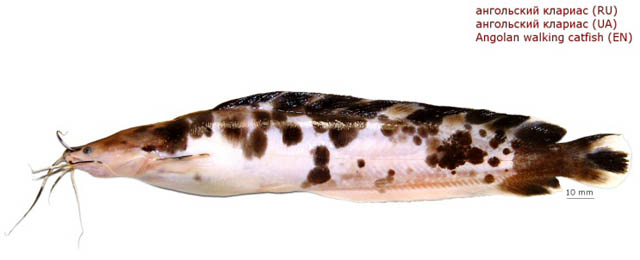| Clariidae (Airbreathing catfishes) |
| 35 cm TL (male/unsexed) |
|
demersal; freshwater; pH range: 7 - 9; dH range: 15 - 40, |
| Africa: lower and middle Congo River basin including Ubangi and Kasai drainages (Ref. 248); also reported from the Maiko-Loboya in lower Lualaba (Ref. 106245). Also present in lower Ogooué in Gabon, Kouilou and Chiloango in Republic of Congo (Ref. 81644) and Cuanza and Chiloango in Angola (Ref 120641). |
|
Dorsal spines (total): 0-0; Dorsal soft rays (total): 67-84; Anal soft rays: 55-69. Diagnosis: head length 22.3-27.1% SL (Ref. 101841). Head pointed in dorsal outline; snout slightly rounded; eyes dorsally located (Ref. 248). Interorbital distance 41.4-48.6% HL (Ref. 81644, 101841). Tooth plates relatively small (Ref. 248), width of premaxillary tooth plate 24.3-30.7% HL, and of vomerine tooth plate 20.9-27.5% HL (Ref. 81644, 101841). Maxillary barbel length 105.1-195.3% HL; outer mandibular barbel length 95.0-134.5% HL (Ref. 81644, 101841). Nasal barbel length 72.1-130.2% HL; inner mandibular barbel length 72.4-108.9% HL (Ref. 81644). Frontal fontanelle long and narrow (`knife-shaped'); occipital fontanelle oval- shaped and relatively large; supraorbital and the `dermosphenotic' joined by a common suture in specimens over 70 mm SL; dorsal and anal fin nearly reaching caudal fin, but not confluent; gill rakers long and slender, increasing with age (Ref. 248). Openings of secondary canals along lateral line visible as irregularly placed white spots on the body (Ref. 248, 81644). Pectoral spine strongly serrated on outside and inside (Ref. 81644, 101841). Surface of cleithrum exposed through skin is intermediate; inner angle formed by both paired bones sharp; cleithrum length 13.0-18.6% HL; dorsal fin length 65.1-73.8% SL; distance from dorsal to caudal fin 0.9-2.7% SL (Ref. 101841). 10-23 gill rakers on first arch (Ref. 81644).
Colouration: preserved specimens with uniform colouration; dorsum, flanks and dorsal parts of paired fins dark brown, ventrum and ventral parts of paired fins pale brown to grey (Ref. 248, 81644, 101841). Some specimens may show irregular pattern of small white spots on body (Ref. 101841). |
| Inhabits rivers, lakes and swamps. Feeds on a variety of food like algae, plants, Hydracarina, larvae of Ephemeroptera, Chironomidae, Ceratopogonidae, remains of remains (Coleoptera) and fish remains (Cichlidae, Anabantidae) (Ref. 248). Maximum size reported in Lower Guinea is 317mm TL (Ref. 81644). |
|
Least Concern (LC); Date assessed: 16 February 2009 Ref. (130435)
|
| harmless |
Source and more info: www.fishbase.org. For personal, classroom, and other internal use only. Not for publication.

